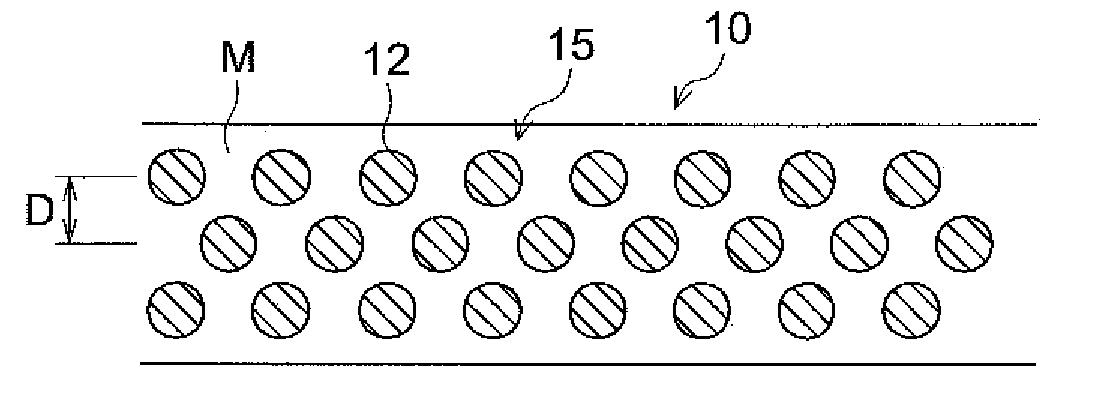Indication member
a technology of indication and member, applied in the field of indication members, can solve the problems of large energy required, inability to observe the history of the structural color change, and inability to maintain and fix the change in the response to a stimulus from the outsid
- Summary
- Abstract
- Description
- Claims
- Application Information
AI Technical Summary
Benefits of technology
Problems solved by technology
Method used
Image
Examples
preparation example 1
of Fine Particle Dispersion Liquid
(Synthesis of Sphere)
[0099]A monomer mixed solution was prepared by a process of warming 71 parts by weight of styrene (St), 20 parts by weight of n-butyl acrylate (BA), and 9 parts by weight of methacrylic acid (MAA) to 80° C. On the other hand, a surfactant solution in which 0.4 parts by weight of dodecyl sulfonic acid sodium was dissolved in 263 parts by weight of ion-exchange water was heated to 80° C., and this surfactant solution and the above monomer mixed solution were mixed and then subjected to a dispersing process for 30 minutes by a mechanical dispersion device “CLEARMIX” (manufactured by M-Technique Co., Ltd.), whereby an emulsion dispersion liquid was prepared.
[0100]Into a reaction container equipped with a stirring device, a heating cooling device, a nitrogen introducing device, and a raw material and auxiliary agent feeding devices the above emulsion dispersion liquid and a surfactant solution in which 0.1 parts by weight of dodecyl ...
preparation example 2
of Fine Particle Dispersion Liquid
[0101]Into a surfactant solution in which 0.02 parts by weight of dodecyl sulfonic acid sodium was dissolved in 100 parts by weight of ion-exchange water, 20 parts by weight of spherical particles of titanium oxide (rutile-type, average particle size: 120 nm, CV value: 7.1, refractive index 2.76) synthesized by a titanium alkoxide polymerization method were dispersed, whereby Fine particle dispersion liquid (2) was obtained. The average particle size, CV value and refractive index of fine particles in this Fine particle dispersion liquid (2) are indicated in Table 1.
preparation example 3
of Fine Particle Dispersion Liquid
[0102]Ten parts by weight of polyester (PEs) was dissolved in 40 parts by weight of toluene, whereby a polyester dispersion liquid was prepared. This polyester dispersion liquid was mixed with a surfactant solution in which 0.2 parts by weight of dodecyl sulfonic acid sodium was dissolved in 200 parts by weight of ion-exchange water, and the resultant mixture was subjected to a dispersion process for 30 minutes by a mechanical dispersion device “CLEARMIX” (manufactured by M-Technique Co., Ltd.), whereby an emulsion dispersion liquid was prepared. This emulsion dispersion liquid was heated at 60° C. under a reduced pressure so as to evaporate toluene, whereby Fine particle dispersion liquid (3) composed of true spherical fine particles with high monodispersity was obtained. The average particle sizes CV value and refractive index of fine particles in this Fine particle dispersion liquid (3) are indicated in Table 1.
PUM
| Property | Measurement | Unit |
|---|---|---|
| refractive index | aaaaa | aaaaa |
| particle size | aaaaa | aaaaa |
| thickness | aaaaa | aaaaa |
Abstract
Description
Claims
Application Information
 Login to View More
Login to View More - R&D
- Intellectual Property
- Life Sciences
- Materials
- Tech Scout
- Unparalleled Data Quality
- Higher Quality Content
- 60% Fewer Hallucinations
Browse by: Latest US Patents, China's latest patents, Technical Efficacy Thesaurus, Application Domain, Technology Topic, Popular Technical Reports.
© 2025 PatSnap. All rights reserved.Legal|Privacy policy|Modern Slavery Act Transparency Statement|Sitemap|About US| Contact US: help@patsnap.com


